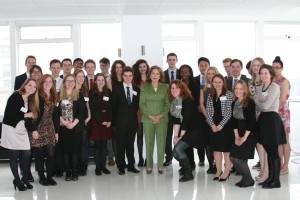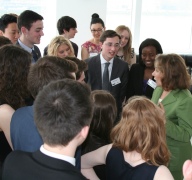James Turner asks how can non-selective state schools support their brightest students
Today’s Ofsted report on provision for the highly able children in non-selective schools highlights some alarming statistics: two thirds of students getting level 5 in English and Maths at age 11 do not go on to get an A or A* in both those subjects at GCSE. This represents a ‘lost 65,000’, many of whom should be university-bound, including to the most selective institutions.
This latest research echoed a study commissioned by the Sutton Trust from Alan Smithers, which revealed last summer that the UK ranks poorly in international comparisons of the highly able. Whereas on average in the OECD 3.1 percent of students reach the highest levels of performance at age 15 in Maths, just 1.7 percent of English pupils do the same — and the majority of those are found in independent and grammar schools. This places the UK 26th out of 34 OECD countries. It is a tremendous waste of talent and goes some way to explaining why our leading universities and professions look like they do – dominated by those from better off backgrounds.
So there’s clearly an urgent need to consider how best to support able students in non-selective state schools, who make up the majority of the pupils in our system, and particularly those comprehensive schools and academies in areas of socio-economic disadvantage. This has been a preoccupation for the Trust since our foundation in 1997: while opening up grammar and independent schools to low and middle income students is an important plank of our work, our largest beneficiaries are the tens of thousands of students in non-selective schools who have been reached by our university summer schools and other programmes. Now we have a focus on how we can engage with these students earlier on, in key stages three and four between the ages of 11 and 16, so that the ‘lost students’ stay at the top of their game.
In fact, this week also saw the launch of a new and innovative programme the Trust is funding in partnership with the Kent Academies Network and Fitzwilliam College, Cambridge. The scheme is being run through a group of six academies collectively with their independent school sponsors. It picks up students from low and middle income backgrounds in Year 9 for a four-year programme of support through residential Easter and Summer schools and mentoring. The course will give students the opportunity to strengthen their knowledge of core subjects, develop new skills and interests, engage with academically like-minded young people, be coached by inspirational teachers, and experience a range of enrichment and extracurricular activities in, for example, art, music, literature, drama and science.
And thanks to funding from JP Morgan, the Sutton Scholars initiative is also getting up and running at University College London and will host its first sessions after the summer. The project seeks to create a learning community of 100 highly able pupils from challenging London schools, picking them up in year 8 and working with them throughout their school journey. It selects pupils who are in the top five percent of the national ability range, and in schools with high levels of deprivation and low attainment rates. The group will be introduced to new academic ideas, methods of study and ways of thinking that – we hope – will enable them to reach their academic potential.
Both these programmes provide an interesting model which we believe, once evaluated and if proven successful, would be ripe for expansion through other universities, partnerships and networks of schools. But how, on a more systematic basis, can we encourage schools to engage – and even commission – this type of activity for their brightest students?
The answer, as you might expect, is far from straightforward. In a non-selective state school facing multiple challenges, catering for the most able, to stretch them from a B to an A grade for example, is not necessarily a priority – basic literacy and numeracy, behaviour, and ensuring student welfare and safety is. Furthermore, there may be only a handful of students in a school who are achieving at this very high level – and so how much resource can a Head devote to supporting them? Second, for all their faults, the dismantling of national programmes for gifted and talented young people – and the ceding of more decision-making to schools – has made the job of spreading best practice and ensuring universal coverage harder. Arguably, provision for the most able has actually gone into reverse.
These issues can partly be addressed through a greater focus on able students in the inspection and performance frameworks. But as our Chairman, Sir Peter Lampl, said in response to the OFSTED report, “these findings should act as a wake-up call to ministers … our research last year found provision for these young people characterised by uneven provision and a lack of clarity about which students should be supported … schools must improve their provision too”.
So surely some sort of half-way house is possible, which recognises school freedoms, whilst encouraging real and substantial activity in a neglected but important area. One way forward would be to create a voluntary scheme which gives head teachers an incentive – perhaps through a top-up to their pupil premium or some other matched-funding provided centrally – to engage with evidence based programmes which have been shown to have an impact on the achievement of the most able students. There are plenty of expert organisations out there who could help schools meet this challenge – Villiers Park, The Brilliant Club, NACE, Children’s University and Into University to name a few . Such a framework would also help us to further build the evidence base around what works in supporting the most able children. This is exactly what our sister charity, the Education Endowment Foundation, is doing to understand what has most impact in raising basic, core academic standards for the poorest children in the most challenging schools.
The consequences of failing to get a clutch of five good GCSEs are well documented and severe. It is right we focus on those young people. But the failure of a bright student from a low/middle income to realise their true potential is equally a personal tragedy and one that, in an increasingly competitive world, our economy can ill afford.



